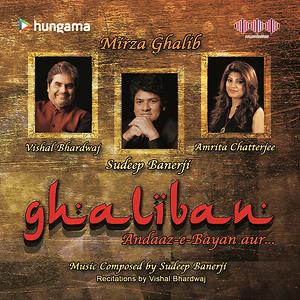Ghaliban/ Sudeep Banerji, Amrita Chatterjee - ghazals
By Narendra Kusnur
Album: Ghaliban - Andaaz-e-Bayan
Artistes: Sudeep Banerji, Amrita Chatterjee, Vishal Bhardwaj
Genre: Ghazals
Label: Hungama
Rating: *** 1/2
Most ghazal singers have the desire to record the works of Mirza Ghalib. After all, he has been the most respected Urdu poet India has produced.
On the album Ghaliban- Andaaz-e-Bayan singers Sudeep Banerji and Amrita Chatterjee choose six classics. Both have fine vocal timbres and their coordination comes across rather well.
However, one doesn't know whether it was a great idea for Vishal Bhardwaj to recite couplets before or in the middle of songs. He’s a remarkable filmmaker and composer, but here, his style sounds repetitive, adding little value and in some cases, interrupting the flow.
On the compositions, Banerji focuses more on guitar, sarangi and percussion. The orchestration is pleasant and doesn’t overpower the words. Beginning with the popular ‘Dil-e-Nadaan Tujhe Hua Kya Hai’, the singers proceed to sing ‘Yeh Na Thi Hamari Kismat’, where the arrangement is reminiscent of the Jagjit Singh-Lata Mangeshkar album Sajda.
Banerji shows a distinct Pankaj Udhas influence on ‘Koi Ummeed Bar Nahin Aati’, and Chatterjee is in great form on the solo ‘Nuqtacheen Hai Gham-e-Dil Usko Sunaaye Na Baney’, whose introduction has an R.D. Burman flavour.
‘Har Ek Baat Pe Kehte Ho Tum Ke Tu Kya Hai’ takes you back to the early Jagjit-Chitra Singh days, with the singers taking turns, interchanging lines and then singing in chorus. The album ends with ‘Ibn-e-Maryam Hua Kare Koi’, which has an air of melancholy. Here, Banerji displays his maturity, getting the right expression and nuance.
Over the years, Ghalib has been recorded by various artistes, from Begum Akhtar, Mehdi Hassan and Suraiya to Jagjit Singh, Pankaj Udhas and Talat Aziz to Roopkumar Rathod, Sumona Roy Biswas and Somesh Mathur. Even K.L. Saigal, Lata Mangeshkar, Talat Mahmood and Mohammed Rafi have released some gems.
Keeping that in mind, some old-timers may not really get into this album, since all these songs have been done time and again. Yet, Ghaliban is a credit-worthy effort on its own, and is capable of spreading the Ghalib magic to the younger generation of ghazal listeners.




Comments
Post a Comment